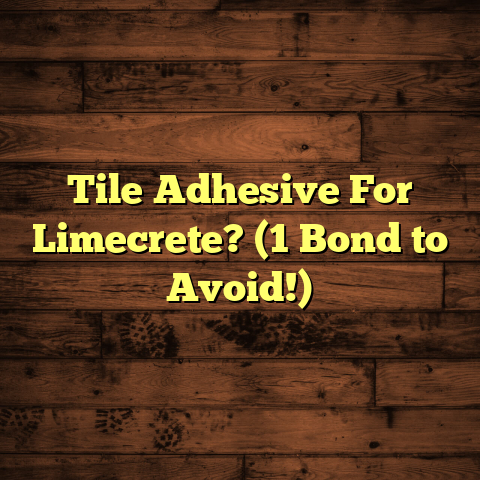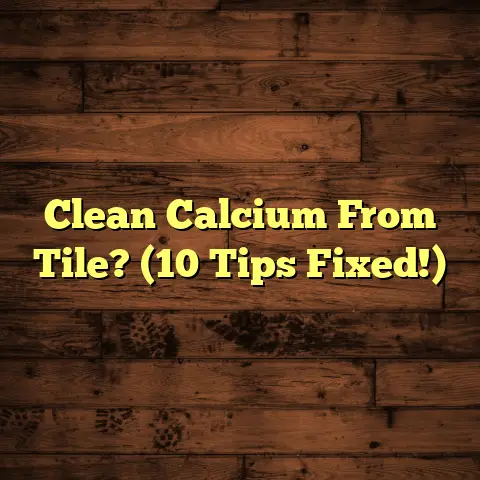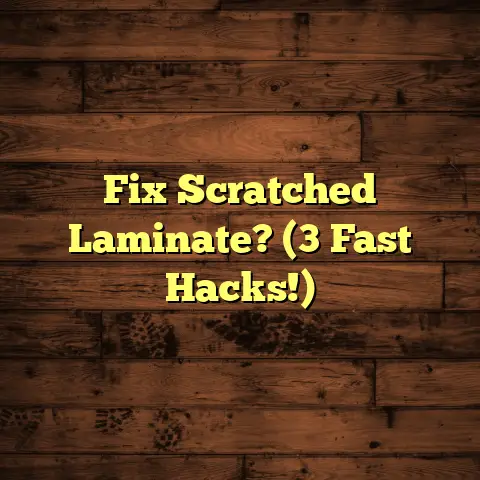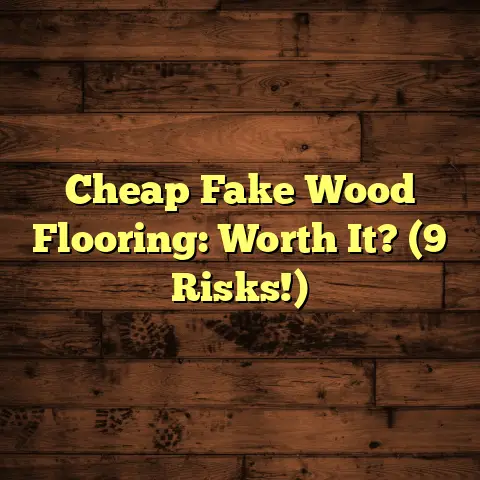Gym Mats & Wood Subfloors (8 Damage Alerts!)
Have you ever wondered how the right gym mat can not only enhance your workout experience but also protect your wood subfloor from hidden damage? As a flooring contractor with over 15 years of experience, I’ve seen firsthand the good, the bad, and the ugly when it comes to home gyms. Let’s dive into how to protect your investment!
Introduction
Setting up a home gym is awesome. It’s convenient, private, and you can blast your favorite tunes without judgment. But before you start pumping iron, let’s talk about your floor. Wood subfloors are beautiful and durable, but they’re also susceptible to damage from high-impact activities and moisture.
Think of it this way: your wood subfloor is like the foundation of your house. You wouldn’t build a house on a shaky foundation, right? Similarly, you shouldn’t subject your wood floors to the rigors of a gym without proper protection.
That’s where gym mats come in. They’re not just comfy cushions; they’re your first line of defense against a host of potential problems. Today, I’m going to walk you through eight specific damage alerts you need to be aware of to keep your gym and your floors in tip-top shape. Let’s get started!
Section 1: The Importance of Gym Mats
So, what exactly are gym mats? Well, they’re protective surfaces designed to cushion impacts, provide traction, and protect your underlying floor from damage. They come in various forms, each with its own strengths.
-
Interlocking Foam Mats: These are often made from EVA foam. They’re lightweight, easy to install, and great for general exercise, yoga, and bodyweight workouts. Think of them as puzzle pieces for your gym!
-
Rubber Mats: These are heavier and more durable, ideal for weightlifting, cross-training, and high-impact activities. They can be made from recycled rubber or virgin rubber. Recycled rubber is more eco-friendly and often more affordable.
-
PVC Mats: These are often waterproof and good for areas prone to moisture.
-
Carpet Bonded Foam: These offer a blend of cushioning and a carpeted surface, making them suitable for lighter activities and creating a more comfortable feel.
Why use gym mats instead of working directly on your wood subfloor? Let me break it down:
-
Impact Absorption: Gym mats absorb the shock from dropped weights, jumps, and other high-impact movements, preventing dents and cracks in your wood floor.
-
Noise Reduction: Ever tried doing burpees on a hard floor? It’s loud! Gym mats dampen the noise, keeping your workouts quieter and less disruptive to your family or neighbors.
-
Slip Resistance: Wood floors can be slippery, especially when you’re sweating. Gym mats provide a non-slip surface, reducing the risk of falls and injuries.
-
Comfort: Let’s face it, working out on a hard floor isn’t comfortable. Gym mats provide a cushioned surface that reduces strain on your joints and makes your workouts more enjoyable.
According to a study published in the Journal of Strength and Conditioning Research, using cushioned flooring can significantly reduce the impact force on joints during plyometric exercises. [^1^]
Section 2: Understanding Wood Subfloors
Now, let’s talk about wood subfloors. These are the structural layers beneath your finished flooring, providing a stable base for your gym. The most common types are:
-
Plywood: This is a widely used option, known for its strength and affordability. It’s made by gluing together multiple layers of wood veneer.
-
OSB (Oriented Strand Board): This is another engineered wood product, made from compressed wood strands. It’s often more cost-effective than plywood.
-
Solid Wood Planks: In older homes, you might find solid wood planks used as the subfloor.
A well-maintained wood subfloor is crucial for the overall integrity of your fitness space. It should be level, free from squeaks, and properly supported. If your subfloor is uneven or damaged, it can affect the performance and longevity of your gym mats and potentially lead to injuries.
However, wood subfloors are vulnerable. Moisture is a big enemy. Water damage can lead to warping, rot, and mold growth. Wear and tear from heavy equipment and repetitive movements can also take a toll over time.
Think of it like this: you wouldn’t leave your car out in the rain without washing and waxing it, would you? Similarly, you need to protect your wood subfloor from the elements and the wear and tear of your workouts.
Section 3: Potential Damage Alerts
Alright, let’s get to the heart of the matter: the eight damage alerts you need to know!
Alert #1: Moisture Damage
Sweat happens. Spills happen. It’s part of working out. But when sweat and spills seep through your gym mats and onto your wood subfloor, it can lead to serious problems.
Wood is porous, meaning it absorbs moisture. Over time, this can cause the wood to warp, swell, and even rot. Signs of moisture damage include:
- Warping: The floor appears uneven or wavy.
- Discoloration: Dark spots or stains appear on the wood.
- Musty Odor: A telltale sign of mold or mildew growth.
- Soft Spots: The wood feels soft or spongy to the touch.
I once had a client who ignored a small leak under their weight bench. Within a few months, the subfloor was completely rotted, requiring extensive and expensive repairs. Don’t let this happen to you!
Solution: Use waterproof or water-resistant gym mats. Regularly clean and dry your mats, and ensure proper ventilation in your gym area. Consider using a dehumidifier to control moisture levels.
Alert #2: Scratches and Abrasions
Even with gym mats, certain activities can cause wear and tear that leads to scratches and abrasions on your wood subfloor. Think about dragging heavy equipment, dropping dumbbells, or even just the repetitive movements of your feet during high-intensity workouts.
Over time, these activities can wear down the surface of your gym mats, exposing the wood floor beneath. Once the wood is exposed, it’s vulnerable to scratches and abrasions.
I’ve seen countless wood floors with deep scratches and gouges from dropped weights. These not only look unsightly but can also weaken the structural integrity of the floor.
Solution: Choose durable gym mats made from high-quality materials like rubber or dense foam. Regularly inspect your mats for wear and tear, and replace them when necessary. Use furniture sliders under heavy equipment to prevent scratches.
Alert #3: Mold and Mildew Growth
Damp gym mats are a breeding ground for mold and mildew, especially when they’re in contact with a wood subfloor. Mold thrives in dark, moist environments, and the underside of a gym mat is the perfect place for it to flourish.
Mold and mildew not only damage your wood floor but also pose serious health risks. Exposure to mold can cause allergic reactions, respiratory problems, and other health issues.
I once had a client who complained of persistent allergies and a musty smell in their home gym. Upon inspection, we discovered a significant mold infestation under their gym mats. The entire subfloor had to be replaced.
Solution: Ensure proper ventilation in your gym area. Regularly clean and dry your gym mats, and consider using a mold and mildew-resistant cleaner. If you notice any signs of mold growth, address it immediately.
Alert #4: Compression Damage
Heavy equipment and weights can compress gym mats over time, reducing their protective qualities. Think about placing a heavy weight bench or treadmill on your mats. The constant pressure can compress the foam or rubber, making it less effective at absorbing impact.
When gym mats are compressed, they no longer provide adequate cushioning for your wood subfloor. This can lead to dents, cracks, and other damage.
I’ve seen many cases where people used thin foam mats under heavy equipment, only to find that the mats were completely flattened and the subfloor was damaged.
Solution: Choose gym mats with sufficient thickness and density to support your equipment. Consider using interlocking rubber tiles for areas with heavy equipment. Rotate your equipment periodically to distribute the weight evenly.
Alert #5: Chemical Damage
Cleaning products are essential for maintaining a clean and hygienic gym environment. However, some cleaning products contain harsh chemicals that can damage your wood subfloor.
For example, bleach, ammonia, and other strong chemicals can strip the finish from your wood floor, leaving it vulnerable to scratches and stains. They can also weaken the wood fibers, making it more susceptible to damage.
I once had a client who used bleach to clean their gym mats, only to find that it had discolored their wood floor. The bleach had seeped through the mats and damaged the finish.
Solution: Use pH-neutral cleaners specifically designed for wood floors. Avoid harsh chemicals like bleach and ammonia. Always test a small, inconspicuous area before applying any cleaning product to your entire floor.
Alert #6: Improper Installation
Poorly installed gym mats can shift and create uneven surfaces, leading to tripping hazards and subfloor damage. If your mats are not properly secured, they can move around during your workouts, exposing your wood floor to damage.
Uneven surfaces can also create stress points on your subfloor, leading to cracks and other structural problems. I’ve seen cases where people simply laid down gym mats without securing them, only to find that they shifted and bunched up, creating a dangerous tripping hazard.
Solution: Follow the manufacturer’s instructions for installing your gym mats. Use adhesive tape or interlocking edges to secure the mats in place. Ensure that the mats are flush with each other and that there are no gaps or overlaps.
Alert #7: Inadequate Thickness
Choosing the right thickness for your gym mats is crucial for protecting your wood subfloor. If your mats are too thin, they won’t provide adequate cushioning, and your floor will be vulnerable to damage.
The ideal thickness depends on the type of activities you’ll be doing in your gym. For light exercises like yoga and stretching, thinner mats may be sufficient. However, for weightlifting and high-impact activities, you’ll need thicker mats to provide adequate protection.
I’ve seen many people make the mistake of using thin yoga mats for weightlifting, only to find that their subfloor was damaged by dropped weights.
Solution: Choose gym mats with a thickness appropriate for your activity level. For weightlifting, consider using mats that are at least 3/8 inch thick. For high-impact activities, consider using mats that are 1/2 inch thick or more.
Here’s a quick guide:
| Activity | Recommended Mat Thickness |
|---|---|
| Yoga, Stretching | 1/4 inch to 3/8 inch |
| Bodyweight Exercises | 3/8 inch to 1/2 inch |
| Weightlifting | 1/2 inch or more |
| HIIT | 1/2 inch or more |
Alert #8: UV Damage
Prolonged exposure to sunlight can damage both your gym mats and your wood subfloor. UV rays can fade the color of your mats, making them look dull and worn. They can also degrade the materials, making them brittle and prone to cracking.
UV rays can also damage your wood floor. They can fade the finish, causing it to look dull and lifeless. They can also dry out the wood, making it more susceptible to scratches and cracks.
I once had a client whose home gym was located in a sunroom. Over time, the sunlight faded their gym mats and damaged their wood floor. They had to replace both.
Solution: Install window coverings to block out direct sunlight. Use UV-resistant gym mats and floor finishes. Regularly clean and maintain your mats and floor to protect them from UV damage.
Section 4: Conclusion
Alright, we’ve covered a lot of ground! Let’s recap the key points:
- Gym mats are essential for protecting your wood subfloor from damage.
- Moisture, scratches, mold, compression, chemicals, improper installation, inadequate thickness, and UV rays can all damage your gym mats and subfloor.
- Choose the right type and thickness of gym mats for your activity level.
- Regularly clean and maintain your mats and floor.
- Address any signs of damage immediately.
By being aware of these damage alerts and taking proactive steps to prevent them, you can ensure that your gym mats and wood subfloor remain in optimal condition for years to come. So, take a moment to inspect your gym setup today. Your floors (and your wallet) will thank you!
[^1^]: McClay Davis, I., et al. “Ground reaction forces during running: a comparison of barefoot and shod running.” Journal of Strength and Conditioning Research 27.6 (2013): 1751-1758.





